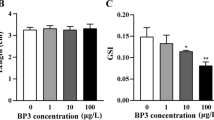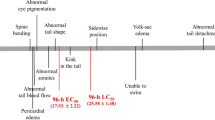Abstract
Cannabidiol (CBD), a medically active component of hemp, is a popular ingredient in healthcare and personal-care products. The increasing demand for CBD and the legalization of hemp growth may promote chronic exposure of non-target organisms to CBD. In this study, the reproductive toxicity of CBD was investigated on adult zebrafish. With CBD treatment, female zebrafish spawned less with higher natural mortality and malformation rates. Both female and male zebrafish showed a decreased gonadosomatic index with an increased percentage of pre-mature oocytes and sperm and had an increased hepatosomatic index with decreased content of vitellogenin. The value of estrogen/testosterone (E2/T) decreased in female zebrafish and increased in male zebrafish. Sex hormone synthesis genes were downregulated in ovaries and upregulated in testicles, except for cyp11a, in contrast to the other genes. Apoptosis-related genes were upregulated in the zebrafish brain, gonad, and liver. These results show that CBD might damage the reproductive function by inducing an apoptotic response, further inhibiting zebrafish reproductive ability.






Similar content being viewed by others
Data availability
Data used in this study are included in this article and available on reasonable request from the corresponding author.
Abbreviations
- CBD:
-
Cannabidiol; intake
- E2:
-
Estrogen
- T:
-
Testosterone
- HPGL axis:
-
Hypothalamus-pituitary-gonad-liver axis
- THC:
-
Tetrahydrocannabinol
- CBN:
-
Cannabinoid
- OR:
-
Odd ratio
- DMSO:
-
Dimethylsulfoxide
- Vtg:
-
Vitellogenin
- GSI:
-
Gonadosomatic index
- HIS:
-
Hepatosomatic index
- LOD:
-
Limit of detection
- LOQ:
-
Limit of quantity
- LC50:
-
Median lethal concentration
- GnRH:
-
Gonadotropin-releasing hormone
- LH:
-
Luteinizing hormone
- FSH:
-
Follicle-stimulating hormone
- HPGL axis:
-
Hypothalamus-pituitary-gonad-liver axis
- ROS:
-
Reactive oxygen species
References
Ahmed KT, Amin MR, Shah P et al (2018) Motor neuron development in zebrafish is altered by brief (5-hr) exposures to THC (∆9-tetrahydrocannabinol) or CBD (cannabidiol) during gastrulation. Sci Rep 8:10518. https://doi.org/10.1038/s41598-018-28689-z
Apter D (1997) Development of the hypothalamic-pituitary-ovarian axis. Ann N Y Acad Sci 816:9–21. https://doi.org/10.1111/j.1749-6632.1997.tb52125.x
Bayrampour H, Zahradnik M, Lisonkova S et al (2019) Women’s perspectives about cannabis use during pregnancy and the postpartum period: An integrative review. Prev Med 119:17–23. https://doi.org/10.1016/j.ypmed.2018.12.002
Berger BA, Stolz U, Colvin J et al (2021) Epidemiology of cannabidiol related cases reported in the National Poison Data System – 2019–2020. Am J Emerg Med 48:218–223. https://doi.org/10.1016/j.ajem.2021.04.065
Brentnall M, Rodriguez-Menocal L, De Guevara RL et al (2013) Caspase-9, caspase-3 and caspase-7 have distinct roles during intrinsic apoptosis. BMC Cell Biol 14:32–32. https://doi.org/10.1186/1471-2121-14-32
Brooks S, Tyler CR, Sumpter JP (1997) Egg quality in fish: What makes a good egg? Rev Fish Biol Fisheries 7:387–416. https://doi.org/10.1023/A:1018400130692
Cao F, Zhu L, Li H et al (2016) Reproductive toxicity of azoxystrobin to adult zebrafish (Danio rerio). Environ Pollut 219:1109–1121. https://doi.org/10.1016/j.envpol.2016.09.015
Carty DR, Thornton C, Gledhill JH et al (2018) Developmental effects of cannabidiol and Δ9-tetrahydrocannabinol in zebrafish. Toxicol Sci 162:137–145. https://doi.org/10.1093/toxsci/kfx232
Carvalho RK, Santos ML, Souza MR et al (2018) Chronic exposure to cannabidiol induces reproductive toxicity in male Swiss mice. J Appl Toxicol 38:1215–1223. https://doi.org/10.1002/jat.3631
Feinshtein V, Erez O, Ben-Zvi Z et al (2013) Cannabidiol enhances xenobiotic permeability through the human placental barrier by direct inhibition of breast cancer resistance protein: An ex vivo study. Am J Obstet Gynecol 209:573.e571-573.e515. https://doi.org/10.1016/j.ajog.2013.08.005
Fink SL, Cookson BT (2005) Apoptosis, pyroptosis, and necrosis: mechanistic description of dead and dying eukaryotic cells. Infect Immun 73:1907–1916. https://doi.org/10.1128/IAI.73.4.1907-1916.2005
Flouriot G, Pakdel F, Valotaire Y (1996) Transcriptional and post-transcriptional regulation of rainbow trout estrogen receptor and vitellogenin gene expression. Mol Cell Endocrinol 124:173–183. https://doi.org/10.1016/s0303-7207(96)03960-3
Gore AC (2002) GnRH: The master molecule of reproduction. Springer, Boston, MA
Govoroun M, McMeel OM, D’Cotta H et al (2001) Steroid enzyme gene expressions during natural and androgen-induced gonadal differentiation in the rainbow trout. Oncorhynchus Mykiss 290:558–566. https://doi.org/10.1002/jez.1106
Gülck T, Møller BL (2020) Phytocannabinoids: Origins and biosynthesis. Trends Plant Sci 25:985–1004. https://doi.org/10.1016/j.tplants.2020.05.005
How ZT, Gamal El-Din M (2021) A critical review on the detection, occurrence, fate, toxicity, and removal of cannabinoids in the water system and the environment. Environ Pollut 268:115642. https://doi.org/10.1016/j.envpol.2020.115642
Jensen HM, Korbut R, Kania PW et al (2018) Cannabidiol effects on behaviour and immune gene expression in zebrafish (Danio rerio). PloS One 13:e0200016. https://doi.org/10.1371/journal.pone.0200016
Krajewski S, Krajewska M, Ellerby LM et al (1999) Release of caspase-9 from mitochondria during neuronal apoptosis and cerebral ischemia. Proc Natl Acad Sci U.S.A 96:5752–5757. https://doi.org/10.1073/pnas.96.10.5752
Liu T, Liu S, Ma L et al (2017) Oogenesis, vitellogenin-mediated ovarian degeneration and immune response in the annual fish Nothobranchius guentheri. Fish Shellfish Immunol 66:86–92. https://doi.org/10.1016/j.fsi.2017.05.015
Luckenbach JA, Early LW, Rowe AH et al (2005) Aromatase cytochrome P450: cloning, intron variation, and ontogeny of gene expression in southern flounder (Paralichthys lethostigma). J Exp Zool Part a, Comp Exp Biol 303:643–656. https://doi.org/10.1002/jez.a.198
Marvel M, Levavi-Sivan B, Wong TT et al (2021) Gnrh2 maintains reproduction in fasting zebrafish through dynamic neuronal projection changes and regulation of gonadotropin synthesis, oogenesis, and reproductive behaviors. Sci Rep 11:6657. https://doi.org/10.1038/s41598-021-86018-3
Mastroianni N, Postigo C, de Alda ML et al (2013) Illicit and abused drugs in sewage sludge: Method optimization and occurrence. J Chromatogr A 1322:29–37. https://doi.org/10.1016/j.chroma.2013.10.078
Miller WL, Gucev ZS (2014) Chapter 31 - Disorders in the initial steps in steroidogenesis. In: New MI, Lekarev O, Parsa A et al (eds) Genetic Steroid Disorders. Academic Press, San Diego, pp 145–164
Neradugomma NK, Drafton K, Mor GG et al (2019) Marijuana-derived cannabinoids inhibit uterine endometrial stromal cell decidualization and compromise trophoblast-endometrium cross-talk. Reprod Toxicol 87:100–107. https://doi.org/10.1016/j.reprotox.2019.05.064
Newton K, Wickliffe KE, Maltzman A et al (2019) Activity of caspase-8 determines plasticity between cell death pathways. Nature 575:679–682. https://doi.org/10.1038/s41586-019-1752-8
OECD (2012) Section 2: Effects on biotic systems No. 229: Fish short term reproduction assay.(Eds), OECD Guidelines for the testing of Chemicals. Paris, Organization for Economic Cooperation and Develepment. https://www.oecd-ilibrary.org/environment/test-no-229-fish-short-term-reproduction-assay_9789264185265-en
Oksala R, Karimaa M, Simola O et al (2018) CYP11A1 inhibition as a therapeutic approach for the treatment of castration resistant prostate cancer. J Clin Oncol 36:340–340. https://doi.org/10.1200/JCO.2018.36.6_suppl.340
Ow Y-LP, Green DR, Hao Z et al (2008) Cytochrome c: Functions beyond respiration. Nat Rev Mol Cell Biol 9:532–542. https://doi.org/10.1038/nrm2434
Pandelides Z, Thornton C, Faruque AS et al (2020a) Developmental exposure to cannabidiol (CBD) alters longevity and health span of zebrafish (Danio rerio). Geroscience 42:785–800. https://doi.org/10.1007/s11357-020-00182-4
Pandelides Z, Thornton C, Lovitt KG et al (2020b) Developmental exposure to Δ(9)-tetrahydrocannabinol (THC) causes biphasic effects on longevity, inflammation, and reproduction in aged zebrafish (Danio rerio). Geroscience 42:923–936. https://doi.org/10.1007/s11357-020-00175-3
Peng X, Sun X, Yu M et al (2019) Chronic exposure to environmental concentrations of phenanthrene impairs zebrafish reproduction. Ecotoxicol Environ Saf 182:109376. https://doi.org/10.1016/j.ecoenv.2019.109376
Pradhan A, Olsson PE (2015) Zebrafish sexual behavior: role of sex steroid hormones and prostaglandins. Behav Brain Funct 11:23. https://doi.org/10.1186/s12993-015-0068-6
Rose J, Holbech H, Lindholst C et al (2002) Vitellogenin induction by 17β-estradiol and 17α-ethinylestradiol in male zebrafish (Danio rerio). Com Biochem Physiol: Toxicol Pharmacol 131:531–539. https://doi.org/10.1016/S1532-0456(02)00035-2
Sainz-Cort A, Jimenez-Garrido D, Muñoz-Marron E et al (2021) Opposite roles for cannabidiol and δ-9-Tetrahydrocannabinol in psychotomimetic effects of cannabis extracts: A naturalistic controlled study. J Clin Psychopharmacol 41:561–570. https://doi.org/10.1097/jcp.0000000000001457
Smolinsky AN, Doughman JM, Kratzke L-TC et al (2010) Zebrafish (Danio rerio) androgen receptor: Sequence homology and up-regulation by the fungicide vinclozolin. Comp Biochem Physiol: Toxicol Pharmacol 151:161–166. https://doi.org/10.1016/j.cbpc.2009.10.001
Sullivan CV, Yilmaz O (2018) Vitellogenesis and yolk proteins, fish. In: Skinner MK (ed) Encyclopedia of Reproduction, 2nd edn. Academic Press, Oxford, pp 266–277
USFDA (2018) FDA approves first drug comprised of an active ingredient derived from marijuana to treat rare, severeforms of epilepsy. US Food and Drug Administration. https://www.fda.gov/news-events/press-announcements/fda-approves-first-drugcomprised-active-ingredient-derived-marijuana-treat-rare-severe-forms
Valim Brigante TA, Abe FR, Zuardi AW et al (2018) Cannabidiol did not induce teratogenicity or neurotoxicity in exposed zebrafish embryos. Chem Biol Interact 291:81–86. https://doi.org/10.1016/j.cbi.2018.06.008
Wu X-J, Williams MJ, Kew KA et al (2021) Reduced vitellogenesis and female fertility in gper knockout zebrafish. Front Endocrinol 12. https://doi.org/10.3389/fendo.2021.637691
Zhang Z, Zhu B, Ge W (2015b) Genetic analysis of zebrafish gonadotropin (FSH and LH) functions by TALEN-mediated gene disruption. Mol Endocrinol 29:76–98. https://doi.org/10.1210/me.2014-1256
Zhang X, Danaceau JP, Chambers EE (2015a) Quantitative analysis of THC and its metabolites in whole blood using LC-MS/MS for toxicology and forensic laboratories. Waters Corpoation, Waters Application Note 720005556. https://www.waters.com/nextgen/cn/zh/library/application-notes/2016/quantitative-analysis-thc-metabolites-whole-blood.html
Acknowledgements
We would like to thank Prof. Demetrio Raldua Perez from the Institute for Environmental Assessment and Water Research (IDAEA-CSIC) for his advice during manuscript writing. We would like to thank Editage (www.editage.cn) for English language editing.
Funding
This study was supported by the National Key Research and Development Program of China [grant number 2019YFC1604504], National Natural Science Foundation of China [grant number 31872006], and Beijing Nova Program of Science and Technology [grant number Z191100001119121].
Author information
Authors and Affiliations
Contributions
Lin Li: Methodology, Formal analysis, Writing-original draft. Bei Fan: Conceptualization. Zhiqiang Kong: Formal analysis, Writing—review & editing. Yifan Zhang: Methodology. MengYing Zhao: Methodology. Jesus Simal-Gandara: Formal analysis. Fengzhong Wang: Funding acquisition, Supervision. Minmin Li: Project administration, Conceptualization.
Corresponding author
Ethics declarations
Ethics approval consent to participate
All experiments using zebrafish were performed according to the animal protocol and authorized by the laboratory animal welfare and ethics committee of Chinese Academy of Agricultural Sciences (306–05-2006–025, published by Ministry of Science and Technology of the People’s republic of China).
Consent to publish
Not applicable.
Conflicts of interest
The authors have no relevant financial or non-financial interests to disclose.
Additional information
Responsible Editor: Wei Liu
Publisher's note
Springer Nature remains neutral with regard to jurisdictional claims in published maps and institutional affiliations.
Supplementary Information
Below is the link to the electronic supplementary material.
Rights and permissions
Springer Nature or its licensor (e.g. a society or other partner) holds exclusive rights to this article under a publishing agreement with the author(s) or other rightsholder(s); author self-archiving of the accepted manuscript version of this article is solely governed by the terms of such publishing agreement and applicable law.
About this article
Cite this article
Li, L., Fan, B., Kong, Z. et al. Short-term exposure of Cannabidiol on Zebrafish (Danio Rerio): Reproductive Toxicity. Environ Sci Pollut Res 30, 75668–75680 (2023). https://doi.org/10.1007/s11356-023-27792-7
Received:
Accepted:
Published:
Issue Date:
DOI: https://doi.org/10.1007/s11356-023-27792-7




